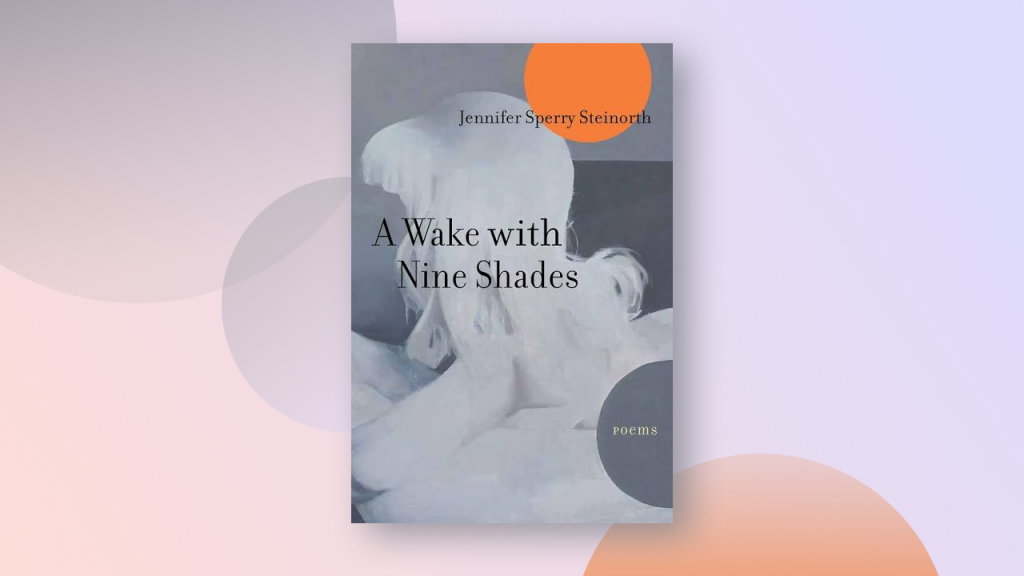Jennifer Sperry Steinorth’s first book, A Wake with Nine Shades (Texas Review Press, 2019) is filled, as its title indicates, with wonderful word play. Steinorth loves where words come from and how they sound against one another. She loves how they carry meaning and how meaning can overwhelm them. She delights in the history and connotations of the words she uses. She is even willing, in the most engaging way, to risk silliness; for instance, the long center section of the book is a series of text messages or quick e-mail between someone resembling this poet and the long dead Robert Frost, a poet who she admits she’s not all that fond of. The piece is called “A Triste Little Tryst w/R. Frost, select billets-doux.” You can sense the pleasure the author felt when she found that title! The poem, by the way, becomes a unique, even powerful, meditation on desire and reading and the way a relationship with literature works in a life devoted to the art. It does all that without losing its almost off-hand feel of flirtation and suggestiveness.
Steinorth’s joy in the language carries over to her formal inventiveness. Some of these poems move all over the page and are shaped by the white space the poet leaves around them. Others, usually narratives, are denser, more like the blocks of lines we are used to in so much contemporary verse, even when they run down the right rather than the left margin. Steinorth writes linked fragments that are scattered throughout the book, creating a visual spine that unites everything. She has a series of haiku that also reappear; sometimes she has even counted the syllables. Of course she calls them “Infernal coo,” so the reader has to reimagine or rediscover the form. Sometimes she will put something in a regular, jaunty rhythm, or even rhyme in a way that accents a song or children’s verse. She will use couplets or three line stanzas when the poems ask for them. The unity is in the way she pushes her syntax so it feels like a personal signature. For instance, the book begins (justified right) in “SelfPortrait with Perennial Shade”:
Slow climber—wisteria—
long the time it takes to pull
down the ladder its climbed up
the trellis it’s scaled to send
its fetching scent aloft to catch—
what? The bee?
The movement of that sentence—forward, then back; up, then down; then with its dashes, almost sideways—is a movement this poet clearly relishes and shows where she sometimes achieves a syntactic mastery.
But this playfulness, this joy in the process of making poems, must never be mistaken for frivolity. Again, as the title indicates, there is a death at the center of this book; in fact, the suicide of a beloved family member. She tells us—“He took his own life. My husband’s/father. My husband’s wife is afraid of—/what?” This grief shapes almost all the poems. It is there with the unpaid bills that appear, in the tension between the marriage partners, between the parents and their children, even in the daily demands of their absolutely normal lives.
Steinorth, who lives in Traverse City, Michigan—that snowbound place!—more often than not must deal with a cold and snowy world. In “Shoveling” (a poem that first appeared in this journal several years ago), the pressures of the ordinary almost overwhelm the poet. She says, “By 9 a.m. you want/bourbon. Will settle//for yesterday’s coffee./In the car to pick up//the kids you find a bill/you thought was paid.” The possible resolution is soiled— “Whatever you’ve lost//should be easy to find./ You’ve been tracking dirt//all over the house.”
But even in Traverse City, the snow will melt. The process of making poems will not end the grief, but it might offer some consolation. The money problems will continue, yet spring will come, even if we’ll only recognize it in a chorus of frogs. Near the end of A Wake with Nine Shades, Steinorth writes another of her haiku, her “Infernal coo ix”:
Music trumps sleep. No use
Calling the police. The party
is spring
frogging . . .
This book is technically accomplished and more emotionally ambitious than most first books. It certainly leaves this reader longing for more.




